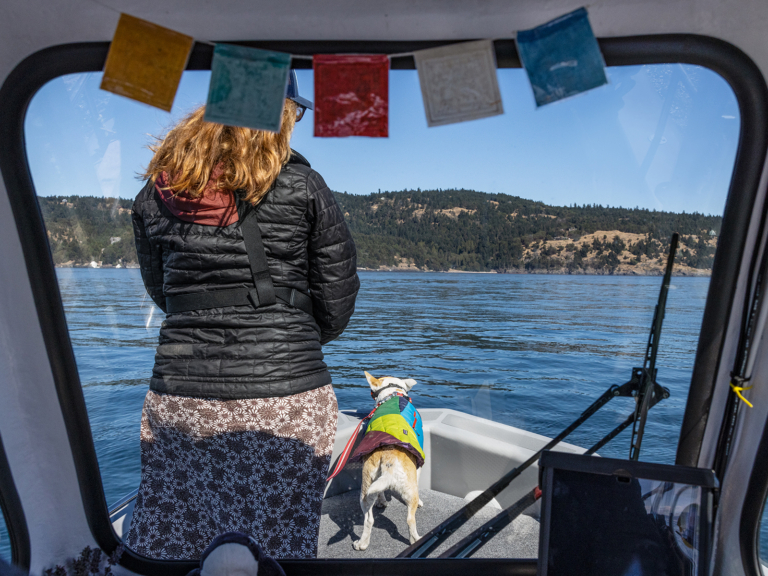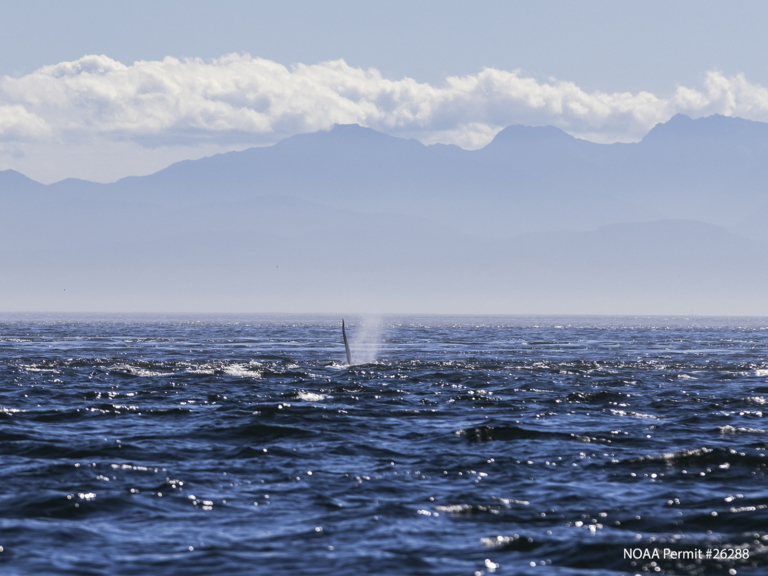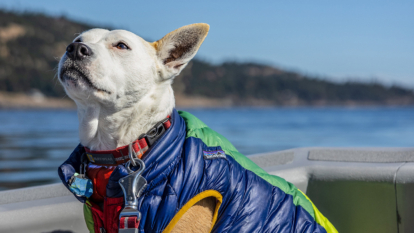Nothing Wasted
The virtue of sniffing scat.
Words by Eba as told to Denis Tuzinovic
Photos by Andrew Burton
Call me Eba.
I also answer to “Eba the Whale Dog” and “Good Girl.” I’m a 7-year-old pit bull/corgi/Jack Russell terrier mix currently sailing around the Salish Sea near the San Juan Islands in Washington state. We’ve just gotten word from our naturalist friend that there are some orcas (also known as killer whales) off the coast. It’s time for me to get to work.
With every crash of a wave, I get whiffs of seals, porpoises and kelp, but I’m less interested in those. I’m more focused on poop. It’s what I’ve been proud to do for the last four years as a vital member of a research team studying the dwindling population of Southern Resident killer whales. Our work is led by Dr. Deborah Giles, who’s been studying these cetaceans for the University of Washington since 2009. Everyone calls her Giles. I just call her Mom.
I love humans, but their noses have nothing on mine. My extra-sensitive snout can smell orca scat on the water’s surface up to a mile away, which is the most noninvasive way to collect samples. From what Mom tells me, these orcas need my help.

Wild Orca’s Science and Research Director—and Eba’s mom—Dr. Deborah Giles has spent 13 years working to protect Southern Resident killer whales. The nonprofit uses the data Eba helps sniff out to advocate for science-based policies that help restore orca populations and their ecosystems.
The Southern Resident killer whales that call the Salish Sea home are composed of the J, K, and L family pods and are one of only two populations of killer whales where we know every individual by name. Their “resident” moniker stems from the fact that, in the past, they usually visit the Salish Sea from May through October, when salmon start making their way to the Fraser River in Canada to spawn.
But their patterns have been changing. A decrease in salmon combined with increased vessel pollution and man-made chemicals in the water have forced orcas to find food elsewhere, and as a result, it’s impacted their numbers. It’s made sampling difficult, but I’m up for the challenge.

There are only 73 Southern Resident killer whales left in the world. Factors like increased vessel pollution have impacted their numbers.
I wasn’t always first mate with the Wild Orca crew, but these days it feels like destiny. Back in 2015, Mom’s sister found me on the streets of Sacramento, California. I had never been so cold. Later that year, Mom adopted me and enrolled me in a training program that teaches dogs to locate scat from endangered animals. After some testing, the head trainer determined that I would be a great scent-detection dog. Well, yeah.
My job with Wild Orca requires me to be poised on the boat’s bow, and as tough as I may be, it doesn’t hurt to have some reinforcements like goggles and my Patagonia puffy, given to me by my buddy Denis. He worked with a local Worn Wear repair team on the design and piecing together various parts of used Down Sweaters and Nano Puff® jackets. It even has this cool pocket for treats.
My first year on the water, I found dozens of orca scat samples. Since then, I’ve tracked down more than 100. From one sample, Mom can detect pregnancies, measure stress levels, identify contaminants, assess diet and generally learn what’s impacting the Southern Resident population. As she likes to say, “finding one poop sample is like finding a gold mine.”
There are currently only 73 Southern Resident killer whales left in our waters. The data we collect is used to inform our community and elected officials about actions that need to be taken to protect the orcas from further decline. It’s going to take collaboration among all of us—government, grassroots organizations, humans and dogs—to help my friends thrive and increase their pod numbers. As I like to say, all paws on deck.

When our gear is beyond repair, we typically recycle it. But Denis Tuzinovic was inspired to turn used Nano Puff® jackets and Down Sweaters into a puffy for Eba. “There’s something romantic about it,” says Denis, who learned about Wild Orca’s work through Patagonia’s grants program. “These coats used to keep people warm. Now, they keep Eba warm while she’s doing important work.”

